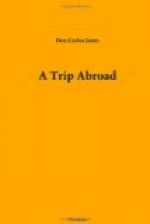All about these temples are indications of ancient graves, from which the Arabs have dug the mummies. As I rode out, a boy wanted to sell me a mummy hand, and another had the mummy of a bird. They may both have been counterfeits made especially for unsuspecting tourists. There are also extensive rock-cut tombs of the ancient kings and queens, which are lighted by electricity in the tourist season. I did not visit them on account of the high price of admission. The government has very properly taken charge of the antiquities, and a ticket is issued for six dollars that admits to all these ruins in Upper Egypt. Tickets for any one particular place were not sold last season, but tourists were allowed to visit all places not inclosed without a ticket.
While in Luxor I visited the American Mission Boarding School for Girls, conducted by Miss Buchanan, who was assisted by a Miss Gibson and five native teachers. A new building, with a capacity for four hundred boarders, was being erected at a cost of about thirty-five thousand dollars. This would be the finest building for girls in Egypt when finished, I was told, and most of the money for it had been given by tourists. I spent a night in Luxor, staying in the home of Youssef Said, a native connected with the mission work. His uncle, who could not speak English, expressed himself as being glad to have “a preacher of Jesus Christ” to stay in his house.
Leaving Luxor, I returned to Cairo for some more sight-seeing, and I had a very interesting time of it. In Gen. 41:45 we read: “Pharaoh called Joseph’s name Zaphenath-paneah; and gave him to wife Asenath, the daughter of Potipherah, priest of On.” Heliopolis, meaning city of the sun, is another name for this place, from whence the wife of Joseph came. It is only a few miles from Cairo, and easily reached by railway. All that I saw of the old city was a lonely obelisk, “probably the oldest one in the world,” standing in a cultivated field and surrounded by the growing crop. It is sixty-six feet high, six feet square at the base, and is well preserved.
The Ezbekiah Gardens are situated in the best portion of Cairo. This beautiful park contains quite a variety of trees, including the banyan, and is a resort of many of the people. Band concerts are held, and a small entrance fee is taken at the gate.
On the thirtieth of the month I visited the Museum, which has been moved to the city and installed in its own commodious and substantial building. This vast collection of relics of this wonderful old country affords great opportunities for study. I spent a good deal of time there seeing the coffins of wood, white limestone, red granite, and alabaster; sacrificial tables, mummies, ancient paintings, weights and measures, bronze lamps, necklaces, stone and alabaster jars, bronze hinges, articles of pottery, and many other things. It is remarkable how some of the embalmed bodies, thousands of years old, are preserved.




